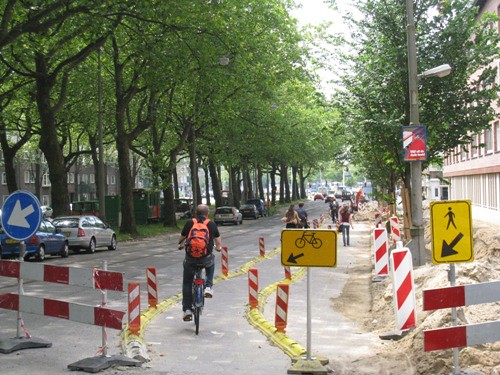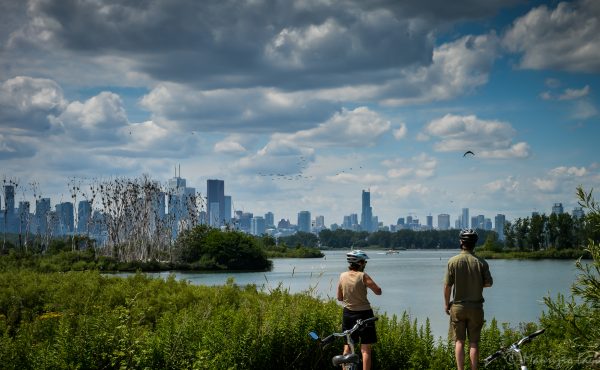
AMSTERDAM – If you regularly walk or bike around Toronto the scene in the photo above is probably familiar to you. Construction work forces you to cross the street (if you’re a pedestrian) or share a narrower lane with traffic (if you’re a cyclist). It can be annoying, but I think for the most part we accept these detours and slight inconveniences as fair payment for the necessary work of building our city. But are there other options; better ways of temporarily closing bits of public space?
In Amsterdam – and presumably the whole of the Netherlands and other more bike-friendly nations – there is a better way. Instead of telling cyclists and pedestrians, “Sorry, you’re out of luck,” this space is temporarily relocated (see photo below). Sure the sidewalk and bike lanes are narrower than usual and not as segregated from car traffic, but the space is preserved and pedestrians and cyclists can continue their journey pretty much undisturbed. It’s functional and it maintains traffic flow (yes, in the Netherlands bike traffic flow is given due consideration). More importantly it tells those not in cars that they matter and that someone respects their needs and was thinking about them when they planned out this construction job. As bizarre as it may sound, realizing this fact can give you a warm feeling inside.

Top photo by gbalogh.




14 comments
this does not compute. in Toronto pedestrian and bicycle traffic is still accommodated, just as car traffic is. The covered walkway is for your protection from falling debris. “the space is preserved and pedestrians and cyclists can continue their journey pretty much undisturbed” in Toronto too, so the only different I see are the nice little signs in the Amsterdam photo. Also note that it appears to be a wide one way street which is significantly different than a two way in terms of accommodating traffic. Maybe you just liked the pretty Amsterdam photo but otherwise I don’t really see the story here.
We’ve very recently started getting this kind of thing in Montreal – just in time as our brand new downtown Maisonneuve bike path runs through 3 major construction sites this summer (2 entertainment district plazas, and new developments at concorida university).
alternative bike paths are created and separated from the road wtih temporary concrete dividers. Bike detours are marked with signs and chevrons painted on the ground. I have even seen signs telling pedestrians that they must cross the street and use the sidewalk rather than use the temporary bike path.
Its a huge step towards legitimizing cycling as a form of transportation on par with cars.
When I was in Grade 12, my girlfriend spent the summer in Greece. When she came back, all she could talk about was how much better it was in exciting, exotic Greece compared to regular, boring Toronto. Oh, the parties! Oh, the beaches! Oh, the relaxed pace of life! Her constant harping on the supposed superiority of this other country got so annoying we broke up. Who wants to be told over and over that they’re in the wrong place?
Spacing is starting to sound like that girlfriend, except instead of Greek parties and beaches, it’s Nordic-Dutch bike lanes, waterfronts, libraries, etc, etc. According to Spacing, if it’s Nordic or Dutch, it’s inherently “better”, even when the difference between here and there is minimal or non-existent.
Take the photos above: how exactly does the Dutch example show a “better way”? You could just as easily argue that the Toronto example is superior, since it’s:
-protected from the elements by a roof (more comfortable);
-protected from traffic by concrete barriers (safer);
-protected from construction ugliness by hoarding (better aesthetics);
The only thing I can see that recommends the Dutch exmaple is the canopy of mature trees. So I guess the lesson for Toronto in this post is plant more trees? If so, I’m all for it!
The two photos aren’t exactly comparable: The Toronto photo is of a construction site, with the necessary shelter for pedestrians. But the Dutch shot looks to be sidewalk excavation or something – and in Toronto, that’s normally covered by a sign saying “Pedestrians walk on the other side of the street”.
Rajio, I’ll admit that I should’ve searched harder for a more illustrative photo in Toronto – I was going for the “pedestrians must cross” situation. Also, I think the fact that the bike lane is maintained is quite significant – I can’t recall seeing a temporary bike lane created in Toronto during construction.
In general though, I will take responsibility for my posts coming off as somewhat Toronto-bashing. That’s definitely not my intention. My intention is for urban enthusiasts (and planners and city officials if they’re reading) to see some examples of how other cities have gone about addressing some particular aspects of urban life and public space. The intent is to expand the metaphorical “tool belt” so that as we continue the work of building and improving Toronto we have more (and hopefully better) options. If we’re already doing things well in certain areas then that’s great – and since I’m not currently living in Toronto I’ll leave those items to other local Spacing contributors. But for now, while I live in Europe, I don’t see any real problem with reporting on different ways of doing things that I happen to like (or dislike in some cases – see https://spacing.ca/toronto/2009/05/19/brussels-transport-impressions/. I’ll endeavour to do it in a more diplomatic way in the future.
Trust me, I do appreciate Toronto and I can’t wait to get back there soon.
I was biking down College street to work last week, and Toronto Hydro vehicles were were parked in the street (taking up an entire car lane) and doing some work. They parked to the right, set up all their barricades, etc, but left the bike lane free! I was really impressed and thanked the Hydro workers for leaving the bike lane open. I know this isn’t typical, but it did feel great to know that the workers had thought of the cyclists.
I definitely take my own liberties in some healthy Toronto-bashing now and then. Nothing pleases me more than pointing out something that Toronto does differently (like treating streetcars as buses on maps) – makes an ex-pat feel useful by providing the outside perspective.
But Spacing is providing a valuable service in recent months by constantly bringing relevant, practical, comparable examples from the rest of world to the eyes of Torontonians. Yes, it might seem to be harping a bit when a post hinges on a little detail like the missing bike detour sign above, but the fact remains that Toronto is only one of dozens of big cities out there that are exciting, successful places to live and we simply do not do enough to learn from other cities. Educating the citizenry about urban streetscapes in Seoul, Amsterdam and even Iowa City can only provide context and helpful education to T.O. in the long run.
I do agree that sometimes Spacing comes across as a blog run by jetsetting trust-fund kids. I’m sure that’s not the case, but the constant articles from far-flung locations make me envious.
I’m reminded by a situation a few months back when construction began on Festival Hall at John and King. The sidewalk on John was suddenly blocked and a sign erected informing pedestrians that the sidewalk was closed. A policeman was stationed to inform pedestrians that they couldn’t continue, nor could they cross to the other side since crossing mid block constituted a ticketable offence – essentially forcing them half a block back to cross at Adelaide and John. A few days later, the police officer disappeared and was replaced by a structure similar to above, which is still there.
One major difference in design, however, is that the stretch between the walkway and the corner of King and John was not completely separated by a concrete divider. The angled access from the corner to the actual walkway was marked by a painted crosswalk-type design, which has since mostly faded. The access area is basically shared by pedestrians walking diagonally to the walkway and cars turning right onto King – if push came to shove, it would not be too difficult to figure who would come out on top.
The pecking order is pretty straightforward. Developers first, cars second and pedestrians third. If the closure of bike lanes last year on Beverley near the AGO is any indication, I don’t think cyclists figure at all in the equation.
Fred, I just didnt see what you saw in the amsterdam photo that was better than in the toronto photo that was directly comparable. im all for an expanded tool-belt too but maybe we just couldnt see what you were driving at here. I, for one, didnt think this post was toronto-bashing but i was jsut confused at its goal. Aside from not having as much foliage, the toronto image seems to show a better solution.
We all know that in Toronto the car is still considered the idol most people are most likely to worship.
I’ve seen the following on Toronto streets:
The sidewalk and bike lanes are closed, pedestrians are directed to the opposite sidewalk if there is one, nowhere if there isn’t. Bicycles are left to fend for themselves.
The bike lane is turned into a temporary sidewalk, with barricades, not even a lane closed sign is provided for the now missing bike lane. Bicycles are left to fend for themselves.
Lanes are shifted over during construction so that BOTH bike lanes disappear there may be a temporary sidewalk on one side, but often that disappears to, but all car lanes are maintained. Bicycles are left to fend for themselves.
I don’t remember where I have seen these, but I have seen them all when riding. The concept of retaining a bicycle lane during construction at the expense of motor vehicle space, never seen that. Have seen it for sidewalks though.
I think it’s incredibly valuable to look at what other cities are doing. It’s not just coming up with abstract idea that may or may not be practical, but looking at things that have already been done and are proven to work.
Something like this is particularly great: Is there any reason Toronto can’t include a regulation on construction that says when a sidewalk/bikelane is closed, an alternate space be designated? A little more planning time and a slight budget increase for more pylons is all it takes.
Comming from Cambridge (UK) clearly the importance of cycles cannot be underestimated; I think that this is an excellent idea and surely shows the way forward for ‘intelligent traffic management’.
More importantly, has anything happened recently with the bid to change Toronto’s bylaws so that we don’t need to pay cops to stand around at every construction site in the city? You don’t need to go to Europe to see that the same job can be done just as well and MUCH cheaper by regular people… just go to any other city in Canada.